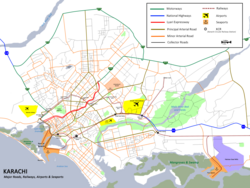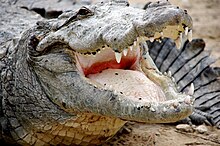This is an old revision of this page, as edited by KindRowboat (talk | contribs) at 00:16, 23 September 2020 (added photos from commons and link to gallery in commons). The present address (URL) is a permanent link to this revision, which may differ significantly from the current revision.
Revision as of 00:16, 23 September 2020 by KindRowboat (talk | contribs) (added photos from commons and link to gallery in commons)(diff) ← Previous revision | Latest revision (diff) | Newer revision → (diff)

Manghopir or Mangopir (Template:Lang-ur) is a neighbourhood in the Malir district of Karachi, Pakistan, that previously was a part of Gadap Town until 2011.
There are several ethnic groups in Manghopir including Muhajirs, Sindhis, Punjabis, Kashmiris, Seraikis, Pakhtuns, Balochis, Memons, Bohras, Ismailis, etc. The population of the neighborhood is Muslim. The population of Gadap Town is estimated to be nearly one million.
Manghopir is a rural area of Karachi, named after Sufi Pir Haji Syed Sakhi Sultan. The area has the oldest Sufi shrines in the city, hot sulphur springs that are believed to have curative powers, and many crocodiles - believed locally to be the sacred disciples of Pir Mangho. Balochs often call this place as ‘Mangi’ or Garm-aab / Sard-aab (due to the presence of the hot & cold springs).
Manghopir Lake

The Manghopir Lake is situated near the shrine of Sufi Pir Mangho and there over hundred Mugger crocodiles in the lake which are fed by the pilgrims.
Sheedis and Festivals
Manghopir is mostly inhabited by one of Pakistan's smallest ethnic communities, Makrani or Sheedi. Sheedi are said to be the descendants of Afro-Arabs from Zanzibar and maintain their distinct Afro-Arab and Omani identity in the midst of the dominating South Asian cultures.
Presently, these African-Pakistanis live in various parts of Karachi. Most are found in Lyari, but they are also found in Malir, Moaach Goth, Manghopir, and further interior at Sindh and Balochistan. Due to Lyari's dominant Sheedi people population, it is often called 'Little Africa'. Some Afro-Arab style festivals and dances like Gowaati, Lewa, Dhamaal, beating Omani style shindo, jabwah, and jasser drums are still popular in Manghopirs Lyari locale. Many forms of folk beliefs and medicines are also still practiced. A prominent Urdu poet and Lyari citizen, Noon Meem Danish, proudly claims to be the great-great-grandchild of an African from Zanzibar. "Now after centuries of cultural amalgamation, Sheedis proudly call themselves Baloch or Makrani."
See also
References
- Baldia Town Archived 2006-02-19 at the Wayback Machine
- Runaway crocodiles returned to Manghopir shrine
External links
24°59′N 67°02′E / 24.983°N 67.033°E / 24.983; 67.033
Categories: